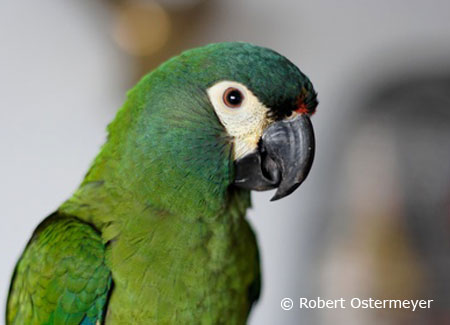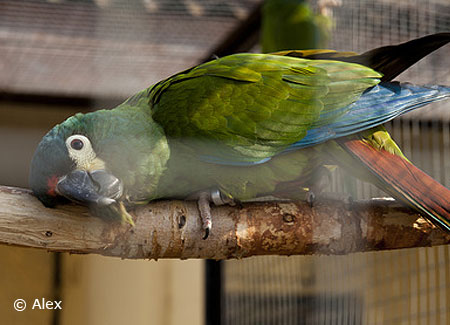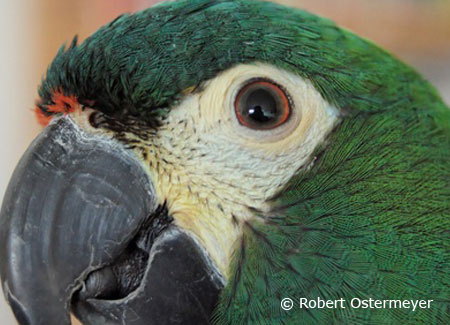[bars]
Common Names: Blue-winged Macaw, Illiger’s Macaws, Mini Macaw
Scientific Name: Primolius maracana
Origin: South America
Relative Size: 16 & 17 inches
Weight: 260-280 grams
Average Lifespan: 45-50 years
Egg Clutch: 2-4 white eggs
Incubation: 25 days
Talking Ability: Moderate
General Information about The Illiger’s Macaw

The Illiger’s Macaw, or more commonly known as the Blue-winged Macaw, is solid dark green with hues of blue that accent the parrot’s plumage. These Mini Macaws look like smaller versions of their larger cousins, the Military Macaws. These pristine parrots look so much like their larger macaw cousins that they are sometimes mistaken.
These blue-winged parrots have long tails that account for much of their size. Their large tails make up half of the macaw’s size and extend outward about seven to eight inches. Their tails have dark colors of maroon, lime, and are tipped with blue. When in flight, the bottoms of the feathers are exposed and canary-yellow feathers can be seen.
[ads]
These smaller parrots have the typical macaw features with white skin and large beady eyes. The eyes are amber in color giving this bird a most striking appearance. The pupil is black and can often be seen pinning when the parrot is excited or talks. The head has a bright tuft of orange-reddish feathering and the belly of the parrot has red as well.
The beaks are black and large in comparison to most parrots their size. Their feet are light beige with black nails, which also makes them stand out. These parrots weigh between 260 to 280 grams. The females tend to get a bit heavier when producing eggs.
Illiger’s Macaws in the Wild
Illiger’s Macaws in the wild are expressive and social. They can be seen foraging, flying, and relaxing with other macaws or conures throughout the day. Though they spend most of their day in medium sized flocks, ranging between seven or twenty birds, many will branch off to relax with their mates in the forest canopy. During mid-noon, it is not uncommon to see these birds nestled next to their mates making loud calls.
These birds are native to South America and are found in Brazil, Paraguay, and Argentina. Their habitat is mainly comprised of forests and highlands. These parrots depend on palms as a staple for their diet. Their large beaks are able to crack the palm nuts and they are a favorite of the parrot. These high caloric dense nuts are perfect as an Illiger’s Macaw will burn a lot of energy throughout the day. During the breeding and nesting period, palms are then used to protect the birds as they are usually surrounded by water.
The breeding habits of these macaws are mysterious, so there isn’t a huge amount of material capturing this event. Instead, the breeding information available has mostly been gathered by people who work tirelessly to breed and rear these mini macaws.
In Brazil, these parrots breed between December and February. The pair will find a cavity inside an old tree where the female will deposit between 2 – 4 white eggs. The mother Macaw will incubate the eggs for roughly 25 days and then both parents partake in feeding the rapidly growing chicks. This ensures better survival.
The young macaws look similar to their parents but have darker eyes and are less colorful until they have matured. Most babies will remain with their parents for at least a year before they branch off to become independent.
Illiger’s Macaws in Captivity

Unfortunately, Illiger’s Macaws are not too common in captivity. It’s more likely someone looking to get a mini macaw will stumble upon a Noble Macaw, a Hahn’s Macaw, or a Severe Macaw first before ever finding an Illiger’s Macaw. These magnificent parrots show up occasionally at bird shows, private breeder’s lists, or are sometimes sold through classified ads.
The low numbers in North America have been attributed to their breeding behaviors in captivity and the lack of people interested in breeding these mini macaws. Though some breeders insist these macaws are prolific when it comes to producing, others insist these parrots are difficult to breed altogether. Whatever the case may be, there are only a handful of breeders who are interested in establishing these macaws in captivity. Many breeders specializing in Illiger’s are trying to ensure these birds remain in the United States, and for this reason, do not handfed their babies. This ensures a viable breeding stock will be available for future generations.
These birds are no longer imported into the United States and they are on the list of the Convention on International Trade in Endangered Fauna and Flora. Their habitat has been destroyed due to agriculture and the fact that farmers seem to equate these parrots as pests. For this reason, many are shot and killed. Another reason these parrots have declined is due to over trapping for the pet trade. Many chicks were removed from tree cavities and sold in the black-market and then shipped across the world. Unfortunately, many of these babies taken from the wild usually starve due to being neglected. Most trappers are only interested in making money through the selling of these birds; therefore, they don’t focus on the upkeep or health of the bird. The intent is to sell them for profit and move on.
Illiger’s Macaws as Pets
An Illiger’s Macaws can make a wonderful pet if handfed and well socialized as they bond strongly to their owners. If neglected or placed away from family household members, they can quickly develop physiological disorders. An owner who has purchased a baby should ensure their bird is well socialized and can cope with being alone while at work. While away, an owner should insure that there are sufficient things to keep the bird from becoming bored.
These parrots will gladly sit upon an owner’s shoulder. A good time to put the bird on your shoulder is when you are doing daily chores or tasks such as paying bills or working on the computer. This bonding time seems to delight the birds and they then become inquisitive. Most will watch their owners work, but many will climb down their owner’s shoulders to investigate and see how they can entice you to play.
When the bird starts to mature, many might become nippy, but it is important the owner not focus on this. If the macaw should bite, the owner can remove their hand back or distract the bird with a toy. Eventually this nippiness will fade. It is advised the owner never yell, make direct eye contact, or scold the bird as this only draws attention to getting bitten. Drawing attention to this behavior only enforces the bird to continue. If the bird is too nippy for a handling session, the owner should place the bird back into its cage as this will give the bird plenty of time to cool down. It will then learn that this is not acceptable behavior.
Talking and Noise Level
One of the drawbacks of owning an Illiger’s Macaw is the noise they make. Though they are considered loud by most pet standards, they are not quite as loud as their larger macaw cousins. If for some reason the bird does become a little noisy, keep the parrot indoors as this will minimize the disturbance to your neighbors. If there are no complaints, then there is no need to worry.
Their talking ability is moderate. These birds are not gifted at talking, but some do learn to say a few words. If an owner wishes to get their bird to talk, the owner should repeat words and phrases in an excited voice. This should be done daily until the bird picks up the sound. Most people, however, tend to buy these mini macaws more for their sleek appearance, comical antics, wonderful personalities, and playful puppy like nature and not so much for their talking abilities.
Toys for your Illiger’s Macaw
Because the parrots are intelligent, they need a great deal of toys to remain happy. These parrots may be on the smaller side compared to their larger macaw cousins, but they do love to chew on things. For this reason, wooden toys should be placed into their cage and rotated to ensure the bird never becomes too bored. If the macaw becomes scared of a new toy, these toys should be gradually introduced to the bird so that it becomes familiar with the object. Some wonderful toys for these birds are foot toys made of beads, wood, unprocessed leather, or rope. Many will spend hours chewing on a hand toy that is well crafted.
Breeding Illiger’s Macaws
The Illiger’s Macaws are bred between December and June in the United States. These birds form strong monogamous bonds that may last a lifetime. Once the birds mature, around two to three years of age, they will start to produce. The female prefers long rectangular or boot shaped boxes. The deep box seems to comfort the female and is a must before she will lay her eggs which are usually between two to four white eggs. While she incubates them, the male will stand guard and feed her.
These macaws breed best in private surroundings. Many Illiger’s Macaw breeders will install cage shields to help the bird focus on breeding rather than their neighbors. It is important the eggs not be checked too often. Also, avoid having loud noises such as lawnmowers around the birds during this time. Disturbing the breeding quarters may cause the female to take flight and crush her eggs.
If the eggs are pulled for incubation, they should remain with the mother for at least 10 days before being placed into an incubator. This 10 day period with the mother really helps to ensure most of the eggs hatch. The temperate of the incubator should be exactly 99.5°F.
Once the babies hatch, they will fledge around 10-11 weeks and be weaned by 13 weeks of age. Some may take longer if handfed or kept alone. Most baby mini macaws are pulled around day 10 after hatching for hand feeding. If the babies are pulled for hand feeding, it’s important the whole clutch be taken as the mother might abandon the rest of the babies.
If the eggs are pulled early enough, there is a good chance a second clutch will be laid.
Selecting the Right Cage
An Illiger’s Macaw may seem like a smaller sized parrot, but they do require a cage that’s quite large. In the wild these birds are constantly foraging, swinging, and playing and their cage should reflect this type of environment. A cage that is three feet in width, four feet in length, and at least four feet in height will do; 3x4x4.
The bars of the cage should not be galvanized or contain zinc. All cages that contain zinc will lead to toxicity for a pet parrot. For this reason, the ideal cage is one that’s powder coated or made of stainless steel.
The cage should have a tray that can be slid in and out for cleaning. This also allows for placement and easy removal of paper on the bottom of the cage. The bottom of the cage should have a grill installed to stop the parrot from having access to his dropped food, feces, or chewed up toys. This will keep the bird healthy.
Food and water bowls should be easily accessed through one large door or small compartmental doors. Many cages have large metal rings to hold the food and water bowls inside the cage.
When placing any toys inside the cage, it is important they never be over food or water bowls. This ensures the droppings do not contaminate them. In the wild a parrot always has access to fresh food and its environment is always clean—the cage should be the same.
It’s important to note the cage should be as large as you can afford and be as large as your home will allow. These birds have a long lifespan and a cage can last a lifetime if properly kept. It is wise to spend money now rather than a few times throughout the parrot’s life.
A Play Stand

A play stand is important for the parrot. It should be a safe place the parrot can sit while the owner is home or while watching television. There are many types of stands that suspend from the ceiling of your home, roll on wheels, or are bolted to wooden boxes. Whatever type of stand that is selected, the owner should take the time to ensure the bird uses this stand whenever outside of its cage. This way, the bird can’t get into dangerous things such as chewing on wire, going into a full flight position and getting hurt by flying into windows, or just getting into other mischief.
Toys should be placed on the stand as most parrots enjoy playing with them there as well. Most stands don’t last long, so the owner should expect to buy several throughout the parrot’s life—especially if they are made of wood.
Feeding Your Illiger’s Macaw
Feeding your bird a proper diet is essential. These birds live in the rainforest and eat all types of fruit, blossoms, and seeds to remain healthy. These birds can be fed anything you eat with the exception of a few toxic foods; avocado, chocolate, and alcohol. If any of these items are given, a veterinarian should be called immediately as the bird my become ill and die.
Giving a pet Illiger’s Macaw fresh cut vegetables has many benefits. There are many essential vitamins and nutrients the birds need to remain in optimal health. Fresh vegetables the birds like are green beans, spinach, kale, broccoli, carrots, peas, corn, or tomatoes. Foods high in vitamin A are carrots, sweet potatoes, yams, and butternut squashes.
These birds also eat a variety for fruits. Fruits the birds seem to enjoy are mangos, cantaloupe, papaya, figs, oranges, or apples just to name a few. When fruit is given, the owner may wish to place them on skewers. This allows the bird to hold the skewer and enjoy the fruit. When giving fruit or vegetables, be sure to clean the cage periodically as dropped foods can settle at the bottom of the cage and bring in ants.
Other items the birds enjoy are cooked brown rice, quinoa, beans, or lentils. If any bean or lentil is given, they should be cooked. Do not give your bird raw beans or legumes.
Along with fruits, vegetables, and unprocessed gains, the parrots should also be given a base diet of seeds and pellets. It is important the seeds contain safflower as Illiger’s Macaws enjoy them. The mixture should contain sun flower seeds as well; however, too many might cause problems down the road. Like all foods, everything should be given in moderation.
Pellets may be given along with the seeds. If your pet is avoiding pellets, sometimes it is wise to remove the seeds. This usually makes the parrot eat these pellets as eventually he will become hungry. Note: Before a feeding schedule is adopted and pellets are placed inside the cage as the only food item, the owner should be sure the macaw has had time to adjust to them before completely removing his seeds.
If an Illiger’s Macaw is fed properly, an owner can expect their macaw to live between 45 and 50 years.
[ads]
